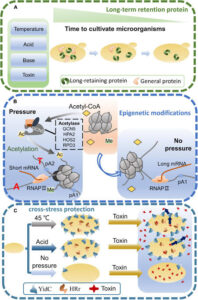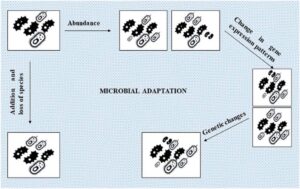Back to: MICROBIOLOGY 200 LEVEL
Welcome to class!
Hey there, brilliant learner! It’s always a joy to have you here. Just like we humans adapt to different conditions—like wearing sweaters in Jos or using fans in Lagos—microorganisms also know how to survive and even thrive in tough environments. Today’s topic is Microbial Adaptation to Environments, and trust me, it’s one of those lessons that’ll make you truly appreciate how smart and resourceful microbes are. Let’s get into it, nice and easy.
Microbial Adaptation To Environments
What Does Adaptation Mean?
Adaptation simply means adjusting to survive. For you, it might mean drinking more water during hot harmattan or using an umbrella during the rainy season. For microbes, adaptation involves changing how they grow, reproduce, or even protect themselves to survive different environmental conditions.

Now here’s the fun part—microorganisms are found literally everywhere: in the hot springs of Yankari, the icy glaciers of Antarctica, deep inside the ocean, and even in the stomachs of cows. How do they do it? Through adaptation!
Types of Environmental Conditions Microbes Adapt To
Temperature
Some microbes love heat! These are called thermophiles, and they can survive in temperatures as high as 70–100°C—like those in volcanic hot springs.
Others prefer cold places, like the freezers in your mum’s kitchen. These are called psychrophiles.
Then we have mesophiles, which love moderate temperatures, just like our body temperature—most disease-causing bacteria fall into this group.
pH (Acidity or Alkalinity)
Acidophiles survive in acidic environments like acidic mine water.
Alkaliphiles can live in basic or alkaline environments, such as soda lakes.
Neutrophiles thrive at neutral pH, just like the pH of our blood.
Salt Concentration
Microbes called halophiles live happily in salty environments like salt mines or salt lakes. They don’t dry up like other organisms would.
Oxygen Availability
Some microbes, like us, need oxygen to survive. These are aerobes.
Others can’t stand oxygen—anaerobes—and can be found in places like deep soil or inside the human intestine.
Some are flexible—facultative anaerobes—they use oxygen when it’s available, but can survive without it too.
Pressure
In the deep sea where pressure is extremely high, you’ll find barophiles—microbes specially adapted to such crushing conditions.

Let’s imagine this: You and your friend go to NYSC camp. You’re from Bayelsa and used to humidity, while your friend is from Kano and used to dry heat. Both of you must adapt—maybe by drinking more water, changing your clothing, or adjusting your sleep pattern. Microbes do the same. Depending on where they find themselves, they develop smart survival strategies—like forming spores, producing special enzymes, or even changing their outer coat!
Summary
- Microbial adaptation is the process by which microbes adjust to survive in different environments.
- They adapt to temperature (thermophiles, mesophiles, psychrophiles), pH (acidophiles, neutrophiles, alkaliphiles), salt (halophiles), oxygen (aerobes, anaerobes, facultative anaerobes), and pressure (barophiles).
- These adaptations allow them to live in extreme places like hot springs, deep seas, salt lakes, and human bodies.
Evaluation
- What type of microbe would you find in a very salty environment?
- Explain the difference between thermophiles and psychrophiles.
- Give one reason why microbial adaptation is important for survival.
- Describe how a facultative anaerobe is different from a strict anaerobe.
You did amazingly well today! See how intelligent and resourceful microbes are? And guess what—you’re just as brilliant! With Afrilearn by your side, learning is always exciting, clear, and made just for you. Keep growing, keep believing in yourself, and get ready for the next lesson—you’ve got this!
